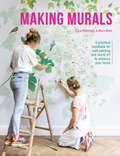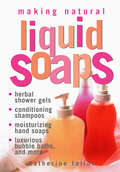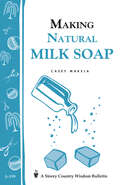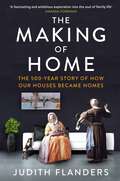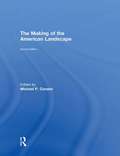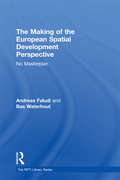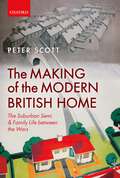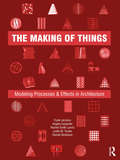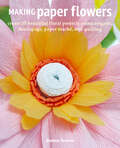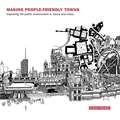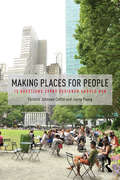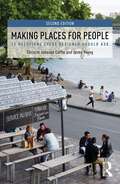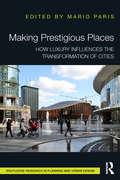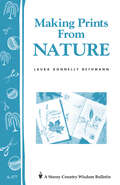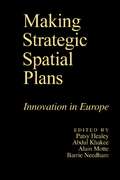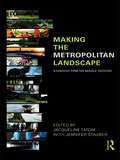- Table View
- List View
Making Murals: A practical handbook for wall painting and mural art to enhance your home
by Clara Wilkinson Mary WestThis practical guide to mural painting explains all the key techniques and design styles you need so that you can get creative in your own home and start 'unsaming' your walls. Murals are a fantastic way to breathe new life into an interior or exterior space. Mural painting is perfect for creating a particular theme in a room, livening up a boring corner of your home and personalising a child's bedroom with their favourite characters. It can also be used to spruce up corridors, hallways and stairwells and other areas of our homes which often get forgotten about. This practical guide to mural painting explains all the essential techniques for getting started including what kind of paints and brushes to use, how to work on various wall surfaces and how to prepare the surface area before painting in order to get the best results. Authors Clara Wilkinson and Mary West, outline the practicalities you need to consider when you are planning a mural such as how much light the area receives and how will it fit in the desired space. They also look at where to find inspiration sources, how to use colour in your work and how different styles of painting suit certain locations. One of the most challenging elements to creating a mural is how to transfer your ideas from paper onto a wall or ceiling and how to ‘scale up’ the design. The authors explore various techniques for transferring mural designs including the traditional grid method and their own innovative ‘doodle grid’ method. Murals offer an exciting opportunity to try out different styles of painting: abstract graphic, painterly and linear are all styles that are looked at in this collection. These painting techniques are explored using step-by-step photography and there is advice on how to combine different techniques to create stunning results. The authors take us on a tour of some of their most exciting wall art and murals and explain, using step-by-step instructions and photography, how you can achieve similar results by either using their design templates or learning how to create your own. Each of these projects is based on a particular theme including Chinoisserie, graphic botanical, celestial, tropical jungle, linear abstract, florals and a painterly abstract design. Just choose your favourite and get started!
Making Natural Liquid Soaps: Herbal Shower Gels, Conditioning Shampoos, Moisturizing Hand Soaps, Luxurious Bubble Baths, and more
by Catherine FailorMake our own liquid soaps and body products right in your kitchen. Catherine Failor shows you how to use her simple double-boiler technique to create luxurious shower gels, revitalizing shampoos, energizing body scrubs, and much more. Step-by-step instructions teach you how to turn basic ingredients like cocoa butter, lanolin, and jojoba into sweet-smelling liquid soaps. You&’ll soon be experimenting with your favorite oils and additives as you craft custom-made products that are kind to your nose and gentle on your skin.
Making Natural Milk Soap: Storey's Country Wisdom Bulletin A-199 (Storey Country Wisdom Bulletin)
by Casey MakelaSince 1973, Storey's Country Wisdom Bulletins have offered practical, hands-on instructions designed to help readers master dozens of country living skills quickly and easily. There are now more than 170 titles in this series, and their remarkable popularity reflects the common desire of country and city dwellers alike to cultivate personal independence in everyday life.
The Making of Home: The 500-year story of how our houses became homes
by Judith FlandersThe idea that 'home' is a special place, a separate place, a place where we can be our true selves, is so obvious to us today that we barely pause to think about it. But, as Judith Flanders shows in this revealing book, 'home' is a relatively new concept. When in 1900 Dorothy assured the citizens of Oz that 'There is no place like home', she was expressing a view that was a culmination of 300 years of economic, physical and emotional change. In The Making of Home, Flanders traces the evolution of the house across northern Europe and America from the sixteenth to the early twentieth century, and paints a striking picture of how the homes we know today differ from homes through history. The transformation of houses into homes, she argues, was not a private matter, but an essential ingredient in the rise of capitalism and the birth of the Industrial Revolution. Without 'home', the modern world as we know it would not exist, and as Flanders charts the development of ordinary household objects - from cutlery, chairs and curtains, to fitted kitchens, plumbing and windows - she also peels back the myths that surround some of our most basic assumptions, including our entire notion of what it is that makes a family. As full of fascinating detail as her previous bestsellers, The Making of Home is also a book teeming with original and provocative ideas.
The Making of the American Landscape
by Michael P. ConzenThe only compact yet comprehensive survey of environmental and cultural forces that have shaped the visual character and geographical diversity of the settled American landscape. The book examines the large-scale historical influences that have molded the varied human adaptation of the continent’s physical topography to its needs over more than 500 years. It presents a synoptic view of myriad historical processes working together or in conflict, and illustrates them through their survival in or disappearance from the everyday landscapes of today.
The Making of the American Landscape
by Michael P. ConzenThe only compact yet comprehensive survey of environmental and cultural forces that have shaped the visual character and geographical diversity of the settled American landscape. The book examines the large-scale historical influences that have molded the varied human adaptation of the continent’s physical topography to its needs over more than 500 years. It presents a synoptic view of myriad historical processes working together or in conflict, and illustrates them through their survival in or disappearance from the everyday landscapes of today.
The Making of the European Spatial Development Perspective: No Masterplan (RTPI Library Series)
by Andreas Faludi Bas WaterhoutThe European Spatial Development Perspective (ESDP) is published in eleven official EU languages and so is the most international planning policy document that exists. This book is the only comprehensive account of the process of preparing, negotiating and adopting this document. It outlines the differing perspectives of the European member states and shows that the last thing its proponents wanted is a masterplan. The Making of the European Spatial Development Perspective is a unique book offering a snapshot of contemporary European spatial planning.
The Making of the European Spatial Development Perspective: No Masterplan (RTPI Library Series)
by Andreas Faludi Bas WaterhoutThe European Spatial Development Perspective (ESDP) is published in eleven official EU languages and so is the most international planning policy document that exists. This book is the only comprehensive account of the process of preparing, negotiating and adopting this document. It outlines the differing perspectives of the European member states and shows that the last thing its proponents wanted is a masterplan. The Making of the European Spatial Development Perspective is a unique book offering a snapshot of contemporary European spatial planning.
The Making Of The Modern British Home: The Suburban Semi And Family Life Between The Wars
by Peter ScottThe Making of the Modern British Home explores the impact of the modern suburban semi-detached house on British family life during the 1920s and 1930s - focusing primarily on working-class households who moved from cramped inner-urban accommodation to new suburban council or owner-occupied housing estates. Migration to suburbia is shown to have initiated a dramatic transformation in lifestyles - from a `traditional' working-class mode of living, based around long-established tightly-knit urban communities, to a recognisably `modern' mode, centred around the home, the nuclear family, and building a better future for the next generation. This process had far-reaching impacts on family life, entailing a change in household priorities to meet the higher costs of suburban living, which in turn impacted on many aspects of household behaviour, including family size. This volume also constitutes a general history of the development of both owner-occupied and municipal suburban housing estates in interwar Britain, including the evolution of housing policy; the housing development process; housing and estate design, lay-outs, and architectural features; marketing owner-occupation and consumer durables to a mass market; furnishing the new suburban home; making ends meet; suburban gardens; social filtering and conflict on the new estates; and problems of 'mis-selling' and 'Jerry building'. Peter Scott integrates the social history of the interwar suburbs with their economic, business, marketing, and architectural/planning histories, demonstrating how these elements interacted to produce a new model of working-class lifestyles and 'respectability' which marked a fundamental break with pre-1914 working-class urban communities.
The Making of Things: Modeling Processes and Effects in Architecture
by Frank Jacobus Angela Carpenter Rachel Smith Loerts Justin M. Tucker Randal DickinsonThe Making of Things is about effect and intention in the schematic architectural model, a deep dive into the nature of architectonic form as the underlying syntax for all architectural work. By focusing on primitive geometries alongside fundamental principles of architectural thinking and making, this book enhances the reader’s capacity to intellectually and physically craft models that effectively communicate intention. With over 650 diagrams, this book acts as an expansive visual glossary that reveals the underlying structure of architectonics and acts as an encyclopedia of formal possibilities. Supporting essays in the book explore the nature of perception, abstraction, and metaphor to provide a theoretical basis of formal effects in architecture. This structure enables readers to make clear and direct connections between the things you construct and the reasons you construct them. This book is a bridge from the what to the why of form-making. It is a pedagogical notebook, a design primer that prompts discourse about the nature of objects. This is a must-have desk reference for beginning architecture and interior design students to stimulate their creative approaches and gain foundational knowledge of the underlying effects of formal typologies and how they manifest themselves in built forms around the world.
The Making of Things: Modeling Processes and Effects in Architecture
by Frank Jacobus Angela Carpenter Rachel Smith Loerts Justin M. Tucker Randal DickinsonThe Making of Things is about effect and intention in the schematic architectural model, a deep dive into the nature of architectonic form as the underlying syntax for all architectural work. By focusing on primitive geometries alongside fundamental principles of architectural thinking and making, this book enhances the reader’s capacity to intellectually and physically craft models that effectively communicate intention. With over 650 diagrams, this book acts as an expansive visual glossary that reveals the underlying structure of architectonics and acts as an encyclopedia of formal possibilities. Supporting essays in the book explore the nature of perception, abstraction, and metaphor to provide a theoretical basis of formal effects in architecture. This structure enables readers to make clear and direct connections between the things you construct and the reasons you construct them. This book is a bridge from the what to the why of form-making. It is a pedagogical notebook, a design primer that prompts discourse about the nature of objects. This is a must-have desk reference for beginning architecture and interior design students to stimulate their creative approaches and gain foundational knowledge of the underlying effects of formal typologies and how they manifest themselves in built forms around the world.
Making Paper Flowers
by Denise BrownCreate your own stunning flowers from paper with these 35 step-by-step projects. Decorate your home using techniques such as simple origami, layered découpage, papier mâché and quilling. Using everyday giftwrap, colourful pages torn from glossy magazines, paper napkins and tissue paper to handmade paper, parchment paper and crinkly crepe paper, Denise Brown guides you through the process of making perfect paper flowers. You can display the flowers in vases, create bouquets and posies to give as gifts, use them to decorate gift boxes and greetings cards, or create wall hangings and window displays. Whether your taste is rooted in Simple yet Stunning, where you will find Oriental Poppies and Frilly Fancies, or Bright and Beautiful, with projects such as Vibrant Dahlias and Waterlilies, or finally, Sophisticated Style, where you can make a Peony Wreath or Elegant Lilies, you will be sure to find the perfect project. Making Paper Flowers is a fantastic new edition of the previously published Paper Flowers.
Making People-Friendly Towns: Improving the Public Environment in Towns and Cities
by Francis TibbaldsMaking People-Friendly Towns explores the way our towns and cities, particularly their central areas, look and feel to all their users and discusses their design, maintenance and management. Francis Tibbalds provides a new philosophical approach to the problem, suggesting that places as a whole matter much more than the individual components that make up the urban environment such as buildings, roads and parks. This informative book suggests the way forward for professionals, decision-makers and all those who care about the future of our urban environment and points the reader in the direction of a wealth of living examples of successful town planning.
Making People-Friendly Towns: Improving the Public Environment in Towns and Cities
by Francis TibbaldsMaking People-Friendly Towns explores the way our towns and cities, particularly their central areas, look and feel to all their users and discusses their design, maintenance and management. Francis Tibbalds provides a new philosophical approach to the problem, suggesting that places as a whole matter much more than the individual components that make up the urban environment such as buildings, roads and parks. This informative book suggests the way forward for professionals, decision-makers and all those who care about the future of our urban environment and points the reader in the direction of a wealth of living examples of successful town planning.
Making Places for People: 12 Questions Every Designer Should Ask
by Christie Johnson Coffin Jenny Young** Honorable Mention at the 2019 ERDA Great Places Awards ** Making Places for People explores twelve social questions in environmental design. Authors Christie Johnson Coffin and Jenny Young bring perspectives from practice and teaching to challenge assumptions about how places meet human needs. The book reveals deeper complexities in addressing basic questions, such as: What is the story of this place? What logic orders it? How big is it? How sustainable is it? Providing an overview of a growing body of knowledge about people and places, Making Places for People stimulates curiosity and further discussion. The authors argue that critical understanding of the relationships between people and their built environments can inspire designs that better contribute to health, human performance, and social equity—bringing meaning and delight to people’s lives.
Making Places for People: 12 Questions Every Designer Should Ask
by Christie Johnson Coffin Jenny Young** Honorable Mention at the 2019 ERDA Great Places Awards ** Making Places for People explores twelve social questions in environmental design. Authors Christie Johnson Coffin and Jenny Young bring perspectives from practice and teaching to challenge assumptions about how places meet human needs. The book reveals deeper complexities in addressing basic questions, such as: What is the story of this place? What logic orders it? How big is it? How sustainable is it? Providing an overview of a growing body of knowledge about people and places, Making Places for People stimulates curiosity and further discussion. The authors argue that critical understanding of the relationships between people and their built environments can inspire designs that better contribute to health, human performance, and social equity—bringing meaning and delight to people’s lives.
Making Places for People: 12 Questions Every Designer Should Ask
by Christie Johnson Coffin Jenny YoungMaking Places for People explores 12 social questions crucial to environmental design. Authors Christie Johnson Coffin and Jenny Young bring perspectives from practice and teaching to challenge assumptions about how places meet human needs. In this expanded second edition, the authors continue to explore the complexities of basic questions, such as: What is the story of this place? What logic orders it? How big is it? How sustainable is it? They consider the impact on making places of pandemic, climate change, human migration, and contemporary discussions of diversity, equity, and justice. Short, approachable, easy-to-read chapters, illustrated with updated examples of projects from around the world, bring together theory, methodology and key research findings. Understanding experienced and research-based connections between people and built form can inspire designs that make places of meaning and delight. This second edition will be essential reading for design students and professionals.
Making Places for People: 12 Questions Every Designer Should Ask
by Christie Johnson Coffin Jenny YoungMaking Places for People explores 12 social questions crucial to environmental design. Authors Christie Johnson Coffin and Jenny Young bring perspectives from practice and teaching to challenge assumptions about how places meet human needs. In this expanded second edition, the authors continue to explore the complexities of basic questions, such as: What is the story of this place? What logic orders it? How big is it? How sustainable is it? They consider the impact on making places of pandemic, climate change, human migration, and contemporary discussions of diversity, equity, and justice. Short, approachable, easy-to-read chapters, illustrated with updated examples of projects from around the world, bring together theory, methodology and key research findings. Understanding experienced and research-based connections between people and built form can inspire designs that make places of meaning and delight. This second edition will be essential reading for design students and professionals.
Making Prestigious Places: How Luxury Influences the Transformation of Cities
by Mario ParisMaking Prestigious Places investigates the spatial dimension of luxury, both as a sector involving activities, operators and investments, and as a system of values acting as a catalyst for recent urban transformations. Luxury shares a well-established connection to the city, as a place of production, consumption and self-representation, and continues to grow despite economic difficulties. This edited collection includes case studies from Europe, North and South America, Asia and the Middle East to create a dialogue around these developments and the challenges presented, such as the tension between the idea of prestige and current values in urban planning, the discussion between academic reflections and operational practices, and how these interact with the long-term economic and social dynamic of the city. With rich analysis and a preface written by Patsy Healey, this book will be an important addition to the discourse on luxury for urban planners and researchers.
Making Prestigious Places: How Luxury Influences the Transformation of Cities
by Mario ParisMaking Prestigious Places investigates the spatial dimension of luxury, both as a sector involving activities, operators and investments, and as a system of values acting as a catalyst for recent urban transformations. Luxury shares a well-established connection to the city, as a place of production, consumption and self-representation, and continues to grow despite economic difficulties. This edited collection includes case studies from Europe, North and South America, Asia and the Middle East to create a dialogue around these developments and the challenges presented, such as the tension between the idea of prestige and current values in urban planning, the discussion between academic reflections and operational practices, and how these interact with the long-term economic and social dynamic of the city. With rich analysis and a preface written by Patsy Healey, this book will be an important addition to the discourse on luxury for urban planners and researchers.
Making Prints from Nature: Storey's Country Wisdom Bulletin A-177 (Storey Country Wisdom Bulletin)
by Laura Donnelly BethmannSince 1973, Storey's Country Wisdom Bulletins have offered practical, hands-on instructions designed to help readers master dozens of country living skills quickly and easily. There are now more than 170 titles in this series, and their remarkable popularity reflects the common desire of country and city dwellers alike to cultivate personal independence in everyday life.
Making Strategic Spatial Plans
by Patsy HealeyA pan-European survey of strategic planning issues in response to technological innovation and its spatial consequences, this text should interest all planners, geographers and others concerned wtih the planning and management of economic development.
Making Strategic Spatial Plans
by Patsy Healey Abdul Khakee Alain Motte Barrie NeedhamA pan-European survey of strategic planning issues in response to technological innovation and its spatial consequences, this text should interest all planners, geographers and others concerned wtih the planning and management of economic development.
Making the Metropolitan Landscape: Standing Firm on Middle Ground
by Jacqueline Tatom Jennifer StauberThe American landscape is an extremely complex terrain born from a history of collective and individual experiences. These created environments, which all may be called metropolitan landscapes, constantly challenge students and professionals in the fields of architecture, design and planning to consider new ways of making lively public places. This book brings together varied voices in urban design theory and practice to explore new ways of understanding place and our position in it.
Making the Metropolitan Landscape: Standing Firm on Middle Ground
by Jacqueline Tatom Jennifer StauberThe American landscape is an extremely complex terrain born from a history of collective and individual experiences. These created environments, which all may be called metropolitan landscapes, constantly challenge students and professionals in the fields of architecture, design and planning to consider new ways of making lively public places. This book brings together varied voices in urban design theory and practice to explore new ways of understanding place and our position in it.
